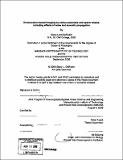Echolocation-based foraging by harbor porpoises and sperm whales, including effects of noise and acoustic propagation
Author(s)
DeRuiter, Stacy L
DownloadFull printable version (46.09Mb)
Other Contributors
Woods Hole Oceanographic Institution.
Advisor
Peter Tyack.
Terms of use
Metadata
Show full item recordAbstract
In this thesis, I provide quantitative descriptions of toothed whale echolocation and foraging behavior, including assessment of the effects of noise on foraging behavior and the potential influence of ocean acoustic propagation conditions on biosonar detection ranges and whale noise exposure. In addition to presenting some novel basic science findings, the case studies presented in this thesis have implications for future work and for management. In Chapter 2, I describe the application of a modified version of the Dtag to studies of harbor porpoise echolocation behavior. The study results indicate how porpoises vary the rate and level of their echolocation clicks during prey capture events; detail the differences in echolocation behavior between different animals and in response to differences in prey fish; and show that, unlike bats, porpoises continue their echolocation buzz after the moment of prey capture. Chapters 3-4 provide case studies that emphasize the importance of applying realistic models of ocean acoustic propagation in marine mammal studies. These chapters illustrate that, although using geometric spreading approximations to predict communication/target detection ranges or noise exposure levels is appropriate in some cases, it can result in large errors in other cases, particularly in situations where refraction in the water column or multi-path acoustic propagation are significant. Finally, in Chapter 5, I describe two methods for statistical analysis of whale behavior data, the rotation test and a semi-Markov chain model. I apply those methods to test for changes in sperm whale foraging behavior in response to airgun noise exposure. Test results indicate that, despite the low-level exposures experienced by the whales in the study, some (but not all) of them reduced their buzz production rates and altered other foraging behavior parameters in response to the airgun exposure.
Description
Thesis (Ph. D.)--Joint Program in Oceanography/Applied Ocean Science and Engineering (Massachusetts Institute of Technology, Dept. of Biology; and the Woods Hole Oceanographic Institution), 2008. Includes bibliographical references.
Date issued
2008Department
Joint Program in Oceanography/Applied Ocean Science and Engineering; Woods Hole Oceanographic Institution; Massachusetts Institute of Technology. Department of BiologyPublisher
Massachusetts Institute of Technology
Keywords
Biology., /Woods Hole Oceanographic Institution. Joint Program in Oceanography/Applied Ocean Science and Engineering., Woods Hole Oceanographic Institution.